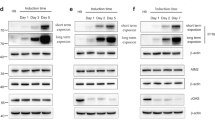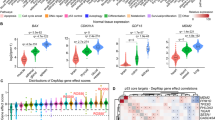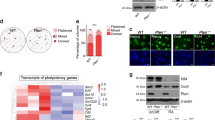Abstract
The tumour suppressor p53 becomes activated in response to upstream stress signals, such as DNA damage, and causes cell-cycle arrest or apoptosis1. Here we report a novel role for p53 in the differentiation of mouse embryonic stem cells (ESCs). p53 binds to the promoter of Nanog, a gene required for ESC self-renewal2,3, and suppresses Nanog expression after DNA damage. The rapid down-regulation of Nanog mRNA during ESC differentiation correlates with the induction of p53 transcriptional activity and Ser 315 phosphorylation. The importance of Ser 315 phosphorylation was revealed by the finding that induction of p53 activity is impaired in p53S315A knock-in ESCs during differentiation, leading to inefficient suppression of Nanog expression. The decreased inhibition of Nanog expression in p53S315A ESCs during differentiation is due to an impaired recruitment of the co-repressor mSin3a to the Nanog promoter. These findings indicate an alternative mechanism for p53 to maintain genetic stability in ESCs, by inducing the differentiation of ESCs into other cell types that undergo efficient p53-dependent cell-cycle arrest and apoptosis.
This is a preview of subscription content, access via your institution
Access options
Subscribe to this journal
Receive 12 print issues and online access
$209.00 per year
only $17.42 per issue
Buy this article
- Purchase on Springer Link
- Instant access to full article PDF
Prices may be subject to local taxes which are calculated during checkout





Similar content being viewed by others
References
Ko, L. J. & Prives, C. p53: puzzle and paradigm. Genes Dev. 10, 1054–1072 (1996).
Mitsui, K. et al. The homeoprotein Nanog is required for maintenance of pluripotency in mouse epiblast and ES cells. Cell 113, 631–642 (2003).
Chambers, I. et al. Functional expression cloning of Nanog, a pluripotency sustaining factor in embryonic stem cells. Cell 113, 643–655 (2003).
Okamoto, K. et al. A novel octamer binding transcription factor is differentially expressed in mouse embryonic cells. Cell 60, 461–472 (1990).
Niwa, H., Miyazaki, J. & Smith, A. G. Quantitative expression of Oct-3/4 defines differentiation, dedifferentiation or self-renewal of ES cells. Nature Genet. 24, 372–376 (2000).
Hoffman, W. H., Biade, S., Zilfou, J. T., Chen, J. & Murphy, M. Transcriptional repression of the anti-apoptotic survivin gene by wild type p53. J. Biol. Chem. 277, 3247–3257 (2002).
Rohwedel, J., Guan, K. & Wobus, A. M. Induction of cellular differentiation by retinoic acid in vitro. Cells Tissues Organs 165, 190–202 (1999).
Sabapathy, K., Klemm, M., Jaenisch, R. & Wagner, E. F. Regulation of ES cell differentiation by functional and conformational modulation of p53. EMBO J. 16, 6217–6229 (1997).
Lutzker, S. G. & Levine, A. J. A functionally inactive p53 protein in teratocarcinoma cells is activated by either DNA damage or cellular differentiation, Nature Med. 2, 804–810 (1996).
Xu, Y. Regulation of p53 responses by post-translational modifications. Cell Death Differ. 10, 400–403 (2003).
Luo, J. L., et al. Knock-in mice with a chimeric human/murine p53 gene develop normally and show wild-type p53 responses to DNA damaging agents: a new biomedical research tool. Oncogene 20, 320–328 (2001).
Savatier, P., Lapillonne, H., van Grunsven, L. A., Rudkin, B. B. & Samarut, J. Withdrawal of differentiation inhibitory activity/leukemia inhibitory factor up-regulates D-type cyclins and cyclin-dependent kinase inhibitors in mouse embryonic stem cells. Oncogene 12, 309–322 (1996).
Bischoff, J. R., Friedman, P. N., Marshak, D. R., Prives, C. & Beach, D. Human p53 is phosphorylated by p60–cdc2 and cyclin B–cdc2. Proc. Natl Acad. Sci. USA 87, 4766–4770 (1990).
Wang, Y. & Prives, C. Increased and altered DNA binding of human p53 by S and G2/M but not G1 cyclin-dependent kinases. Nature 376, 88–91 (1995).
Wu, Z. et al. Mutation of mouse p53 Ser23 and the response to DNA damage. Mol. Cell. Biol. 22, 2441–2449 (2002).
Murphy, M. et al. Transcriptional repression by wild-type p53 utilizes histone deacetylases, mediated by interaction with mSin3a. Genes Dev. 13, 2490–2501 (1999).
Chao, C. et al. p53 transcriptional activity is essential for p53-dependent apoptosis following DNA damage. EMBO J. 19, 4967–4975 (2000).
Chao, C. et al. Cell type- and promoter-specific roles of Ser18 phosphorylation in regulating p53 responses. J. Biol. Chem. 278, 41028–41033 (2003).
Aladjem, M. I. et al. ES cells do not activate p53-dependent stress responses and undergo p53-independent apoptosis in response to DNA damage. Curr. Biol. 8, 145–155 (1998).
Chao, C., Saito, S., Anderson, C. W., Appella, E. & Xu, Y. Phosphorylation of murine p53 at ser-18 regulates the p53 responses to DNA damage. Proc. Natl Acad. Sci. USA 97, 11936–11941 (2000).
Yoshida-Koide, U. et al. Involvement of Ras in extraembryonic endoderm differentiation of embryonic stem cells. Biochem. Biophys. Res. Commun. 313, 475–481 (2004).
Corbet, S. W., Clarke, A. R., Gledhill, S. & Wyllie, A. H. P53-dependent and -independent links between DNA-damage, apoptosis and mutation frequency in ES cells. Oncogene 18, 1537–1544 (1999).
Boley, S. E., Wong, V. A., French, J. E. & Recio, L. p53 heterozygosity alters the mRNA expression of p53 target genes in the bone marrow in response to inhaled benzene. Toxicol. Sci. 66, 209–215 (2002).
Acknowledgements
This work was supported by a National Institutes of Health grant (CA94254) to Y.X. We thank M. Hollstein for the humanized p53 knock-in construct and H. Niwa for the episomal expression vector that expresses in ESC.
Author information
Authors and Affiliations
Corresponding author
Ethics declarations
Competing interests
The authors declare no competing financial interests.
Supplementary information
Supplementary Information
Fig S1, Fig S2, Fig S3, Fig S4 (PDF 206 kb)
Rights and permissions
About this article
Cite this article
Lin, T., Chao, C., Saito, S. et al. p53 induces differentiation of mouse embryonic stem cells by suppressing Nanog expression. Nat Cell Biol 7, 165–171 (2005). https://doi.org/10.1038/ncb1211
Received:
Accepted:
Published:
Issue Date:
DOI: https://doi.org/10.1038/ncb1211
This article is cited by
-
Current view of liver cancer cell-of-origin and proposed mechanisms precluding its proper determination
Cancer Cell International (2023)
-
High NANOG expression correlates with worse patients’ survival in esophageal adenocarcinoma
BMC Cancer (2023)
-
Sodium selenite preserves rBM-MSCs’ stemness, differentiation potential, and immunophenotype and protects them against oxidative stress via activation of the Nrf2 signaling pathway
BMC Complementary Medicine and Therapies (2023)
-
Nuclear complement C3b promotes paclitaxel resistance by assembling the SIN3A/HDAC1/2 complex in non-small cell lung cancer
Cell Death & Disease (2023)
-
p53 isoform expression promotes a stemness phenotype and inhibits doxorubicin sensitivity in breast cancer
Cell Death & Disease (2023)



